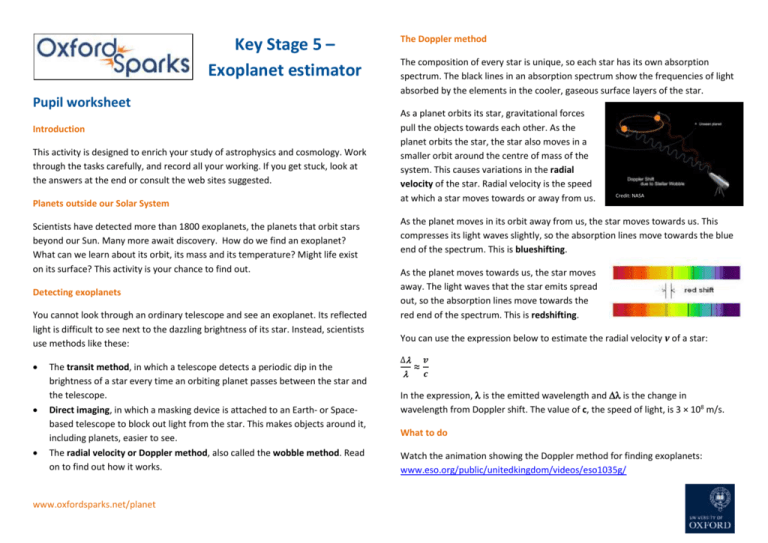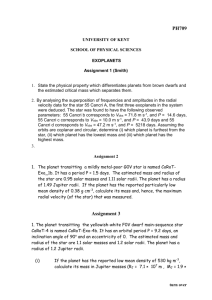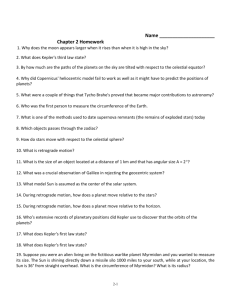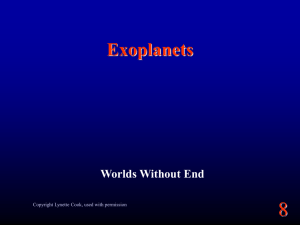Word
advertisement

Key Stage 5 – Exoplanet estimator Pupil worksheet Introduction This activity is designed to enrich your study of astrophysics and cosmology. Work through the tasks carefully, and record all your working. If you get stuck, look at the answers at the end or consult the web sites suggested. Planets outside our Solar System Scientists have detected more than 1800 exoplanets, the planets that orbit stars beyond our Sun. Many more await discovery. How do we find an exoplanet? What can we learn about its orbit, its mass and its temperature? Might life exist on its surface? This activity is your chance to find out. Detecting exoplanets You cannot look through an ordinary telescope and see an exoplanet. Its reflected light is difficult to see next to the dazzling brightness of its star. Instead, scientists use methods like these: The transit method, in which a telescope detects a periodic dip in the brightness of a star every time an orbiting planet passes between the star and the telescope. Direct imaging, in which a masking device is attached to an Earth- or Spacebased telescope to block out light from the star. This makes objects around it, including planets, easier to see. The radial velocity or Doppler method, also called the wobble method. Read on to find out how it works. www.oxfordsparks.net/planet The Doppler method The composition of every star is unique, so each star has its own absorption spectrum. The black lines in an absorption spectrum show the frequencies of light absorbed by the elements in the cooler, gaseous surface layers of the star. As a planet orbits its star, gravitational forces pull the objects towards each other. As the planet orbits the star, the star also moves in a smaller orbit around the centre of mass of the system. This causes variations in the radial velocity of the star. Radial velocity is the speed at which a star moves towards or away from us. Credit: NASA As the planet moves in its orbit away from us, the star moves towards us. This compresses its light waves slightly, so the absorption lines move towards the blue end of the spectrum. This is blueshifting. As the planet moves towards us, the star moves away. The light waves that the star emits spread out, so the absorption lines move towards the red end of the spectrum. This is redshifting. You can use the expression below to estimate the radial velocity v of a star: ∆ ≈ 𝒗 𝒄 In the expression, is the emitted wavelength and is the change in wavelength from Doppler shift. The value of c, the speed of light, is 3 × 108 m/s. What to do Watch the animation showing the Doppler method for finding exoplanets: www.eso.org/public/unitedkingdom/videos/eso1035g/ Key Stage 5 – Exoplanet estimator 51 Pegasi b 51 Pegasi b was one of the first exoplanets to be discovered, in 1995. It was found using the Doppler method. It is the only planet known to be orbiting its star, 51 Pegasi. The star is a Sun-like star. It is about 51 light years from earth in the constellation Pegasus. Your task is to estimate the radial velocity and orbital period of the planet and the distance from its star. You will also estimate its mass. One of the absorption lines on the spectrum for the star has = 656.300000 nm. This shifts to 656.300123 nm when the star is moving away from the observer. Use the expression This graph is similar to the previous one, but it shows the radial velocity trend line. Use the graph to estimate the time between consecutive maxima. This is the time taken by the planet to orbit its star, or its orbital period, T. Graph: adapted from Marcy and Butler Step 3 – Distance from star to planet Kepler’s third law links the orbital period of a planet, T, to the distance from its star, r. The equation is: 𝑇 2 / 𝑟 3 = 4𝜋 2 / G 𝑀∗ Step 1 – Radial velocity a Step 2 – Orbital period ∆ ≈ 𝒗 𝒄 to estimate a value for the maximum radial Where G is the universal gravitational constant and 𝑀∗ is the mass of the star. Use the equation to estimate the value of r, the distance from the planet to its star, using SI units. The mass of the star, 51 Pegasi, is 2.2 × 1030 kg. G is the Gravitational Constant. Its value is 6.674 × 10-11 m3 kg-1 s-2. velocity v of the star, 51 Pegasi. Give your answer in m/s. b Step 4 – Speed of planet The graph shows the change in radial velocity over time for 51 Pegasi. Compare your estimated value for the maximum radial velocity to that shown on the graph. How similar are your values? Now estimate the speed that the planet, 51 Pegasi b, is moving. Use the equation speed = 𝑡𝑖𝑚𝑒 The distance is how far the planet travels in one complete orbit. Assuming a circular orbit, distance = 2πr. The time is its orbital period, T. Graph: James McBride www.oxfordsparks.net/planet 𝑑𝑖𝑠𝑡𝑎𝑛𝑐𝑒 Key Stage 5 – Exoplanet estimator 51 Pegasi b (continued) Planet Distance from star (km) Orbital period (Earth days) Mass of planet (kg) Average surface temperature (K) Mercury 58 × 106 88 330 × 1021 440 Earth 150 × 106 365 6.0 × 1024 288 Jupiter 780 × 106 4332 1.9 × 1027 165 Step 5 – Mass of planet We might say that the planet 51 Pegasi-b is orbiting its star. However, it is actually orbiting the centre of mass of the star-planet system. 51 Pegasi b The two objects have the same orbital period, so the centre of mass does not move and the system does not experience a change in momentum. This means that the planet and the star have equal magnitudes of momentum. Since momentum is equal to the product of mass and velocity: An extra exoplanet 𝑀∗ 𝑣∗ = 𝑀𝑝𝑙𝑎𝑛𝑒𝑡 𝑣𝑝𝑙𝑎𝑛𝑒𝑡 a b Use the equation above the values below to estimate 𝑀𝑝𝑙𝑎𝑛𝑒𝑡 your value of 𝑣𝑝𝑙𝑎𝑛𝑒𝑡 (the speed that the planet is moving) from step 4 𝑀∗ (given in step 3) 𝑣∗ (the radial velocity of the star, calculated in step 1) Your value is an estimate of the minimum mass of the planet. Explain why the value cannot be accurate. 55 Cancri d 55 Cancri d is one of five planets that orbits the star 55 Cancri A. The graph shows how the radial velocity of the star changes over time as a result of the orbit of 55 Cancri d. Graph: James McBride a b c Step 6 – Comparing the planet to those in our Solar System Use the data in the table on the right to compare 51 Pegasi b to some of the planets in our own Solar System. Do you think the planet might be habitable (support life)? Explain your decision. www.oxfordsparks.net/planet 1265 d e From the graph, estimate the orbital period of the planet. Select and use an equation to estimate the distance of the planet from its star. The mass of the star is 1.89 × 1030 kg. Estimate the speed at which 55 Cancri d is moving. Then use data from the table to estimate the speed at which Earth is moving. Compare the two values. Compare the data for 55 Cancri d to the data for the planets in the table above. Its estimated minimum mass is 7.2 × 1027. Do you think the planet might be habitable? Explain your decision. What extra information might help you to decide? Can you use the Internet to find out any of this information? Key Stage 5 – Exoplanet estimator 51 Pegasi b Step 4 Step 1 b speed = Rearranging v≈ 𝑀∗ = 2.20 × 1030 kg r = ∛ [(346 × 103 s × 346 × 103 s × 6.67 × 10-11 m3 kg-1 s-2 × 2.20 × 1030 kg) / 4𝜋 2 ] r = 12 × 109 m Answers a G = 6.67 × 10-11 m3 kg-1 s-2 ∆ ∆ 𝑣 𝑐 ≈ gives ×c Substituting values into the rearranged equation gives v ≈ [(656.300123 nm – 656.300000 nm) / 656.300000 nm] × (3 × 108 m/s) v ≈ 56.2 m/s The graph shows a similar maximum radial velocity to that calculated above. Step 2 The graph shows that the orbital period is approximately 4 days. Step 3 Rearranging 𝑇 2 / 𝑟 3 = 4𝜋 2 / G 𝑀∗ gives r = ∛ [(T2 G 𝑀∗ )/ 4𝜋 2 ] The values to substitute are: T = 4 days = 4 × 24 × 60 × 60 seconds = 346 × 103 seconds www.oxfordsparks.net/planet 𝑑𝑖𝑠𝑡𝑎𝑛𝑐𝑒 𝑡𝑖𝑚𝑒 distance = 2πr = 2π × 12 × 109 m So speed = 2π × 12 × 109 m / 345,600 s = 220 × 103 m/s Step 5 Rearranging 𝑀∗ 𝑣∗ = 𝑀𝑝𝑙𝑎𝑛𝑒𝑡 𝑣𝑝𝑙𝑎𝑛𝑒𝑡 gives 𝑀𝑝𝑙𝑎𝑛𝑒𝑡 = 𝑀∗ 𝑣∗ / 𝑣𝑝𝑙𝑎𝑛𝑒𝑡 = (2.2 × 1030 kg × 56.2 m/s) / 220 × 103 m/s = 560 × 1024 kg In this step the assumption has been made that it is appropriate to use a value of maximum radial velocity for the star, and the orbital speed of the planet. 55 Cancri d a Orbital period ≈ 14 years = 14 × 365 × 24 × 60 × 60 seconds = 440 × 106 seconds b 2 3 2 𝑇 / 𝑟 = 4𝜋 / G 𝑀∗ so r = ∛ [(T2 G 𝑀∗ )/ 4𝜋 2 ] r = ∛ [(440 × 106 s × 440 × 106 s × 6.674 × 10-11 m3 kg-1 s-2 × 1.89× 1030 kg) / 4𝜋 2 ] r = 2.9 × 1012 m c = 9.4 × 1011 m / (365 × 24 ×60 × 60) s = 30 × 103 m/s The speeds of the two planets are similar, with 55 Cancri d moving at a slightly greater speed. The mass of 55 Cancri d is approximately three times greater than that of the planet with the greatest mass in the table, Jupiter. Its orbital period is approximately (14 × 365) = 5110 days, which is slightly greater than that of Jupiter. The distance of 55 Cancri d from its star is much greater than the distance of any of the other planets in the table from their stars. Web links For 55 Cancri d: Web link 1: www.eso.org/public/archives/presskits/pdf/presskit_0005.pdf Useful background information about exoplanets distance = 2πr = 2π × 2.9 × 1012 m = 18 × 1012 m Web link 2: www.planethunters.org Citizen science project in which volunteers analyse data to search for exoplanets. speed = 𝑑𝑖𝑠𝑡𝑎𝑛𝑐𝑒 𝑡𝑖𝑚𝑒 = 18 × 1012 m / 440 × 106 s = 41 × 103 m/s For Earth: distance = 2πr = 2π × 150 × 106 × 103 m = 940 × 109 m speed = 𝑑𝑖𝑠𝑡𝑎𝑛𝑐𝑒 𝑡𝑖𝑚𝑒 www.oxfordsparks.net/planet Web link 3: www.astronomynotes.com/solfluf/s12.htm Further details about finding exoplanets Web link 4: http://eo.ucar.edu/staff/dward/sao/exoplanets/methods.htm Further details about finding exoplanets including an animation









